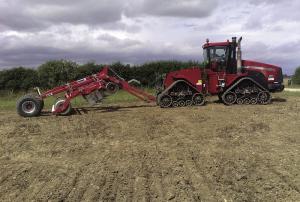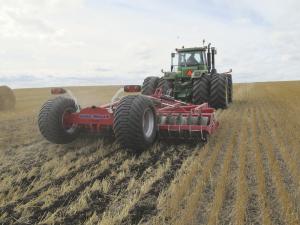2012 - Volume #36, Issue #3, Page #40
[ Sample Stories From This Issue | List of All Stories In This Issue | Print this story
| Read this issue]
Subsoiler Breaks Up Hardpan, Yet Leaves Field Smooth
 |
 |
He recently began importing the subsoiler from England, and is the only North American distributor. “We brought in the first models last fall and demonstrated them for area farmers under a variety of field conditions. We found they did a great job no matter the soil type.”
According to Patterson, the new tillage implement works totally different from other subsoilers on the market. “Most rippers built in North America have a forward slope and a parabolic tine that often brings clay subsoil to the surface. The design of the Sumo subsoiler’s shanks lifts and breaks the hardpan without mixing,” he says. “If you use the Sumo subsoiler during the fall, you’re ready for one-pass seeding the next spring.”
The machine’s most unusual engineering feature is its central backbone frame. The frame runs front to rear down the middle of the machine, forming a rigid spine that carries the entire stress load. “The backbone is strong enough that Sumo put a hitch at the back so the operator can pull a drill or other applicator,” says Patterson.
The rig is equipped with a pair of steel gauge wheels on front, followed by a series of shanks and a large 2-ft. dia. steel roller that runs the full width of the machine to pack the ground. The machine rides on a pair of large 600/50 R 22.5 transport wheels on back.
There are 8 hydraulic cylinders on the machine – 4 to raise and lower the wings, 2 to raise and lower the gauge wheels, and 2 to raise and lower the front end of the machine.
“The shanks are equipped with forward-mounted points that crack the soil profile ahead of each shank and lift and break the hardpan,” says Patterson. “The points open a slot for the shank leg to run in, reducing the amount of energy required to pull the implement through the field.”
Shank depth is controlled hydraulically with adjustable trip-out shanks. Nitrogen accumulators attached to hydraulic cylinders allow the shanks to trip over big rocks. “You can lock in the amount of pressure you want on the nitrogen accumulators by using locking taps,” says Patterson.
The steel gauge wheels are hydraulically adjustable. “The gauge wheels are necessary because with a folding rig like this there’s a tremendous amount of suck on the shanks, and you need something to keep the implement’s wings from sucking too deep into the ground. The gauge wheels also assist in pulling the shanks out of the ground,” says Patterson.
The roller breaks up clods and levels the field. Roller pressure can be adjusted by changing the position of a steel pin. “The roller leaves the ground reasonably compact but doesn’t contribute to compaction,” says Patterson. “It only firms up the top 3 or 4 in. which gives you a solid surface to work on the next spring. If you dig down with a spade, you’ll see the soil below is nice and loose as deep as you want to dig. This spring I was able to drive over Sumo subsoiled fields with my 1/2-ton pickup, which would have been impossible if I had used a conventional subsoiler because it would leave the field loose.”
Patterson currently offers the Sumo in 7 and 9-shank models. The 7-shank unit has a working width of 15 ft. and requires 350 hp. It sells for $68,000. The 9-shank unit has a working width of 18 ft. and requires 450 hp. It sells for $75,000.
“We also plan to offer an 11-leg machine,” says Patterson, who adds that he plans to start selling the Sumo in the U.S. soon.
Contact: FARM SHOW Followup, Sid Patterson, Hepson Equipment, Inc., Site 520, Box 66, Brandon, Man., Canada R7A 5Y5 (ph 204 727-1050; sid@hepson.ca; www.hepson.ca).

Click here to download page story appeared in.

Click here to read entire issue
To read the rest of this story, download this issue below or click here to register with your account number.




